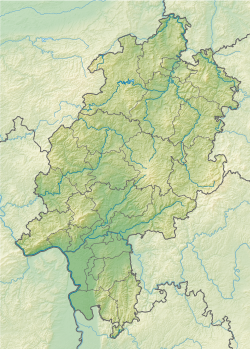Gallery grave Niederzeuzheim
| Gallery grave Niederzeuzheim | ||
|---|---|---|
|
The gallery grave Niederzeuzheim |
||
|
|
||
| Coordinates | 50 ° 28 '54.1 " N , 8 ° 1' 57.2" E | |
| place | Hadamar OT Niederzeuzheim , Hesse , Germany | |
| Emergence | 3500 to 2800 BC Chr. | |
The Niederzeuzheim gallery grave is a megalithic grave complex of the Neolithic Wartberg culture near Niederzeuzheim , a district of Hadamar in the Limburg-Weilburg district ( Hesse ).
location
The facility is located north of Niederzeuzheim on the northern edge of the community forest on the parcel "Der Hohle Stein". It is on a flat hill. 3.5 km to the southeast is the original location of the relocated Oberzeuzheim I gallery grave .
Research history
The grave was rediscovered in the 19th century. Attempts were made at the end of the 19th or beginning of the 20th century to blow up the capstones. In 1911 and 1913, unprofessional excavations were carried out by G. Roedler. The cap stones were smashed. An archaeological investigation was carried out in 1954 under the direction of K. Heymann. In 2004 the grave was restored.
description
architecture
The plant is oriented northwest-southeast. It has a total length of 6.6 m, a width of 2.5 m and an original height of 1.4 m. Remains of a stone mound are still preserved. The burial chamber has an inner length of 5.2 m, a width of 1.6 m and a ceiling height of 1 m. It is sunk into the ground up to half its height, and the chamber was built from basalt slabs . They are between 1 m and 1.8 m long, between 0.5 m and 1 m high and between 0.3 and 0.4 m thick. A dragged capstone lies 9 m from the chamber. It has a length of 2 m, a width of 1.7 m and a thickness of 0.4 m. Fragments of other capstones lie inside the chamber. The gaps between the wall panels were filled with dry stone masonry made of small slabs of limestone. On the east side, these gaps are between 0.4 m and 0.5 m wide. In the west, two wall panels are wedged from the inside with limestone slabs. The floor of the chamber has a paving made of limestone slabs, but this is not completely preserved. The access to the chamber is on the south-eastern narrow side. Here is an anteroom with a length of 0.6 m. There is no perforated door stone between the anteroom and the chamber, but a closure made of three large stones wedged with layered panels.
The building materials for the chamber came from different distances. The next limestone deposit is about 700 m away. Several deposits at distances between 1.5 km and 1.8 km are possible as the place of origin of the basalt. The material requirement is estimated at around 27 t.
Burials
During the 1954 excavation, skeletal remains of at least 25 individuals were recovered. There were twelve men, seven women, four adults of unknown sex and two children. The bones of four men and two women were found in a pit to the northeast of the chamber. It is possible that they were only deposited here by G. Roedler after his investigations.
Additions
Of the ceramic finds, only one shard can be reliably assigned to the time the grave was built. Two other sherds can only be dated generally in prehistory. Other sherds come from Iron Age and medieval faults. The further found offerings is an ax of chert , a hatchet from rocks and a fragment of another half a mandible of a fox , the tibia of a beef , the femur of a pig and the skull of a predator. May also include a quartzite boulder with artificial incision and also the nearby field found flint - tee to the grave. The finds are now in the Wiesbaden Museum .
Say
According to a legend , the grave is said to be a secret exit of the Dornburg .
literature
- Find history. In: Germania. Volume 33, p. 107 ( online ).
- FM Eisenmenger: Niederzeuzheim. In: Soil antiquities in Nassau. Volume 4, 1954, p. 41.
- Fritz-Rudolf Herrmann , Albrecht Jockenhövel : The prehistory of Hesse. Theiss, Stuttgart 1990, ISBN 3-8062-0458-6 , pp. 398-399.
- Heinz-Eberhard Mandera: On the “Lahn Group” of the Hessian-Westphalian stone box culture. In: Find reports from Hessen. Volume 4, 1964, pp. 154-159
- G. Roedler: Nassauische Heimatbilder from the Westerwald. In: Westerwälder Schauinsland. June 15, 1914, p. 76.
- Sabine Schade-Lindig: The stone chamber grave of Niederzeuzheim. Leaflet to the reconstructed gallery grave of the Wartberg group near Hadamar-Niederzeuzheim "Hohler Stein", Limburg-Weilburg district (= Archaeological Monuments in Hesse. Volume 160). Department of Archeology and Paleontology in the State Office for Monument Preservation Hessen, Wiesbaden 2004, ISBN 3-89822-160-1 .
- Sabine Schade-Lindig: Gallery grave of the Wartberg culture in Hadamar-Niederzeuzheim, Limburg-Weilburg district. Restoration of an important Hessian stone chamber grave. In: Hessen Archeology. Yearbook for archeology and paleontology in Hessen. 2004, pp. 50-54.
- Kerstin Schierhold : Studies on the Hessian-Westphalian megalithic. Research status and perspectives in a European context (= Münster contributions to prehistoric and early historical archeology. Volume 6). Leidorf, Rahden / Westf. 2012, ISBN 978-3-89646-284-8 , pp. 298-299.
- Helmut Schoppa : New stone boxes on the Middle Lahn? In: Find reports from Hessen. Volume 5/6, 1966, pp. 82-83.
- Waldtraut Schrickel : Catalog of the Central German graves with Western European elements and the gallery graves of Western Germany. Bonn 1966, pp. 440-441.
- G. Unrath: Anthropological findings on the skeletal remains from the stone box grave of Niederzeuzheim, Limburg-Weilburg district. In: Find reports from Hessen. Volume 17/18, 1977/78 (1980), pp. 77-88.
Web links
- The Megalithic Portal: Niederzeuzheim Chambered Tomb
- KuLaDig: Gallery grave of the Wartberg group near Niederzeuzheim

